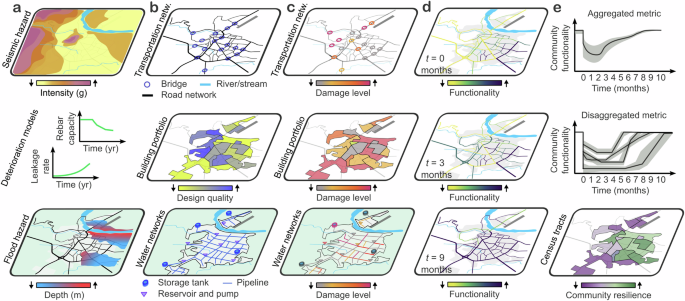Key Takeaways
- Infrastructure resilience modeling faces challenges of data scarcity and complexity, requiring advanced algorithms and multi-source data integration.
- Six actionable strategies are proposed to enhance modeling efforts, focusing on AI and machine learning to promote equitable outcomes.
- Identifying and mitigating biases in modeling is essential for ensuring fair distribution of resilience estimates, particularly for vulnerable populations.
Advancing Infrastructure Resilience Modeling
The traditional infrastructure resilience modeling cycle involves sequential steps from data collection to model validation, often failing to provide comprehensive solutions due to the complexity of system interactions. Researchers have begun utilizing advanced algorithms from artificial intelligence (AI) and machine learning (ML) to inform resilience predictions, particularly where conventional models fall short.
Given the intricate nature of resilience modeling, the article outlines six strategies aimed at promoting smart and equitable infrastructure resilience modeling. These strategies encourage the development of adaptive models that reflect fairness and reliability, while combating the challenges posed by climate change and natural hazards.
One critical pathway emphasizes the need to tackle data scarcity, which often constrains resilience modeling. Techniques such as semi-supervised learning leverage existing unlabeled observations to enhance data representation and improve model accuracy. For instance, utilizing aerial imagery can contribute valuable insights into structural conditions despite lacking explicit response data.
Another strategy encourages the integration of multi-modal data sources, including social sensors and traditional physical data. By fusing diverse data types, models can improve performance and provide more accurate predictions regarding disaster impacts.
Continual learning is also highlighted as a necessary approach in the evolving landscape of infrastructure resilience. As conditions change, algorithms must be capable of adapting their parameters with new observations to maintain accuracy—Bayesian methods are presented as a viable tool for achieving this.
Guiding effective data collection is paramount to facilitate the efficient deployment of resilient infrastructure solutions. Active learning methods can optimize data labeling processes, allowing for faster and more cost-efficient model training.
Moreover, the importance of identifying biases within resilience models is discussed. Algorithms can inadvertently perpetuate inequities, making it essential to scrutinize how modeling decisions impact various social groups. The examination of biases should occur throughout the entire modeling process, from data collection to deployment.
The final strategy focuses on equitably minimizing errors within resilience estimations. By ensuring that the distribution of prediction errors does not disproportionately affect vulnerable populations, models can promote fair and just resilience enhancement.
Overall, the article stresses the need to evolve existing resilience modeling practices by embedding intelligence, equity, and adaptability into the framework, thus ensuring more effective responses to disasters and infrastructural challenges.
The content above is a summary. For more details, see the source article.















